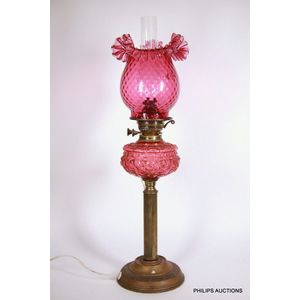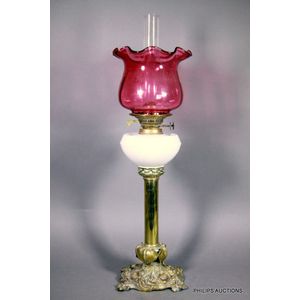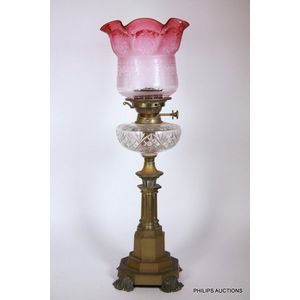Victorian Duplex Banquet Lamp with Cranberry Shade
You must be a subscriber, and be logged in to view price and dealer details.
Subscribe Now to view actual auction price for this item
When you subscribe, you have the option of setting the currency in which to display prices to $Au, $US, $NZ or Stg.
- Victorian Period - The Victorian period of furniture and decorative arts design covers the reign of Queen Victoria from 1837 to 1901. There was not one dominant style of furniture in the Victorian period. Designers used and modified many historical styles such as Gothic, Tudor, Elizabethan, English Rococo, Neoclassical and others, although use of some styles, such as English Rococo and Gothic tended to dominate the furniture manufacture of the period.
The Victorian period was preceded by the Regency and William IV periods, and followed by the Edwardian period, named for Edward VII (1841 ? 1910) who was King of the United Kingdom and the British Dominions and Emperor of India for the brief period from 1901 until his death in 1910. - Opalescent / Opaline - The descriptions of glass as "opalescent" or "opaline" are often used interchangeably by dealers and auction houses. At the upper end of the scale, opalescent / opaline glass can refer to the opal-like milky blue glass produced by Lalique and Etling. It also refers to the pressed glass mass produced in Britain from the 1840s with a milky white edge as sugar-basins, milk jugs and vases were made in great quantities for the mass market, and were sold at fairs along with Staffordshire figures and wooden dolls. A less common type of opalescent glass was made from two layers of glass blown into a mould.
- Decor Bois - "Decor bois" is a French term that translates to "wood decor" in English. It refers to decorative elements painted on porcelain items that simulate decorations in timber, such as carvings.
- Cranberry Glass - Cranberry glass is a type of glass that is characterized by its deep red color. It was first made in the 19th century and was particularly popular during the Victorian era. It was typically used to make decorative items such as vases and figurines. The red color was achieved by adding gold chloride or selenium to the glass mixture during the manufacturing process.
This item has been included into following indexes:
- kerosene / oil lamps, glass colour
- kerosene / oil lamps, type - banquet 169
Visually similar items

A small Victorian spirit lamp with a cranberry glass shade, later 19th century, a brass fluted column upon a cast floral decorated square base with a clear spiral glass bowl shaped font, original fittings and surmounted by a waisted spiral glass ruffled sh

A fine cranberry glass banquet lamp, 19th century, with electric conversion, the English made duplex lamp with a brass reeded stem to a spreading base, a pressed glass font with burner fittings, and an ovoid shade with a optic quilted decor and an undulati

A fine Art Nouveau ruby glass duplex banquet lamp, late 19th century, with a plain columnar stem to an elaborate cast vegetal base with fold over petals, having a milk glass font, chimney, original workings and a waisted shade with an optic rib decor and u

A Victorian brass and glass banquet oil lamp, 19th century, maker's mark of Hinks duplex number 2, the lamp with a cluster column stem to a stepped faceted lower section and foliate feet, a compressed cut crystal font, original burner mechanism and a tulip
